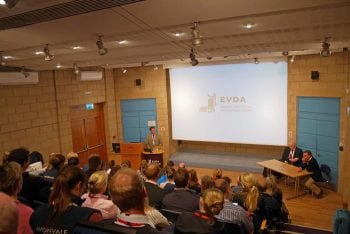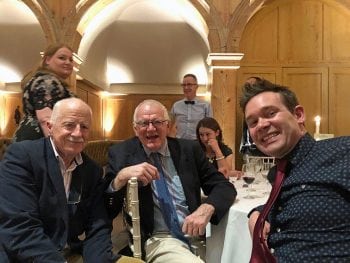25 Jun 2018
Victoria Colgate recaps the organisation's inaugural conference, held in April at The British Racing School in Newmarket.

Image: chalabala / Adobe Stock
The Equine Veterinary Dental Association (EVDA) is a recently established organisation, first formed in 2016 when a group of more than 30 like-minded vets came together with a vision of improving equine veterinary dentistry.
The goal is to raise the profile of dentistry among horse owners and within the equine veterinary sector, by combining education with increased use of evidence-based medicine.
For the first year, membership to the EVDA included free registration to the inaugural conference, held from 27 to 28 April at The British Racing School in Newmarket. With the congress fully subscribed to and a long waiting list, the scene was set for a packed weekend of lectures, quizzes and, of course, a bit of lighter entertainment in the form of the annual dinner.
Despite some unseasonably wet and cold weather (but, then again, this is England) 80 delegates from across Europe and Scandinavia travelled to The British Racing School for the start of congress on the Friday afternoon.
After a welcome address by Karl Holliman from Cliffe Equine Vets and a few bits of housekeeping for the weekend, the afternoon started with a look at some evidence-based equine dentistry.

Neil Townsend from Three Counties Equine Hospital gave a general overview of the most recently published literature in equine dentistry, before more specific questions were answered by the literature in the form of critically appraised topic presentations given by Mr Townsend, as well as the author, Rob Pascoe (Rossdales Equine Hospital) and Nicky Brooks (Equine Dental Clinic).
Evidence-based medicine has long been used in human medicine, but has only recently come to the forefront in the veterinary world. These presentations allowed us to reflect on the reasoning behind (or lack of) the clinical decisions we make and procedures we carry out. It was interesting to realise the research tells us, perhaps rather intuitively, “un-cooled” motorised rasps cause significant heating of the dental tissues, something that can be reduced by water-cooled equipment. However, research has so far failed to identify what, or if any, damage is actually caused by this thermal insult. This is just one example of several poignant points raised highlighting the still vast gaps in our knowledge that must be filled by future research if we are to increase our understanding and provide the best care for our patients.
After a quick coffee break the afternoon was continued by an interactive debate on the appropriateness of sedating the horse for routine dental procedures.
Pete Ravenhill, from B&W Equine Group, and Amy Reynolds, from The Barn Equine Surgery, argued for the motion of “sedation should be carried out in all horses for routine dentistry”, while Mark Grant and Tim Barnett, both from Rossdales Equine Hospital, played devil’s advocate and argued against this, before the discussion was opened up to the floor.
After much enthusiastic debate, I think the take-home message was each case must be reviewed on an individual basis, but we should not be afraid to sedate a horse to allow proper visualisation and oral examination, even if it will tolerate the actual rasping without sedation. Much dental pathology, such as diastema and infundibular caries, can be missed if the mouth cannot be appropriately visualised.
The first day concluded with “happy hour” and a chance for delegates to visit the commercial exhibition and stock up on some new dental equipment, before attending the annual dinner, held at The Jockey Club Rooms in Newmarket.
Listening to comments from delegates the following day, I think it was universally agreed the historic setting of The Jockey Club Rooms provided a “stunning” backdrop to an evening of fantastic food, free-flowing wine, not to mention an entertaining and insightful after-dinner speech by Graham Duncanson.
The second day of congress saw a series of instructive lectures, starting with the fundamentals and progressing to the more advanced, such as interpretation of dental CT images, later in the day.
Mr Ravenhill initially gave a guide to the “perfect oral examination”, before Mrs Reynolds took us through the dental causes of quidding; most often a sign of periodontal disease or other soft tissue trauma in the mouth. It was interesting to note, quidding in the young horse is predominantly due to loose deciduous teeth and will self-resolve once these caps are shed.

Additionally, as Mrs Reynolds highlighted, the painful nature of periodontal disease sometimes necessitated regional anaesthesia just to carry out an oral examination; this acted as a useful introduction to a talk by Carolyn Perkins, from the Equine Dental Clinic in Northern Ireland, on carrying out dental nerve blocks.
Furthermore, Catriona Mackenzie, from Rossdales, took all of the dental experts in the room out of their comfort zone as she explored the non-dental causes for dysphagia in the horse.
A highlight of the congress was the keynote lecture, given by Paddy Dixon, on “Dentistry through the ages”. Prof Dixon took delegates back to the vet school classroom, with a thought-provoking account of equine evolution, from the rabbit-sized Hyracotherium with brachydont teeth, through a great increase in body size to become the modern day Equus caballus with its hypsodont dentition.
Alongside dental evolution, the domestication of the horse was covered, as well as the development of veterinary care, which initially saw great interest and advances, albeit with a lot of bloodletting, blistering and other purgative remedies, before experiencing somewhat of a “dark-age” during the first part of the 20th century as motorised transport replaced the horse throughout the country. Indeed, Prof Dixon reported that, in French textbooks from the 1700s, reports exist of treating sinusitis by trephination and lavage, yet it is only recently, with renewed interest in the horse through its use in sport, our technique has developed from a large flap sinostomy, to less invasive sinoscopy through trephination portals, for treatment.
The morning session concluded with the first EVDA annual meeting, where it was agreed the current committee would stand for a further year before opening the positions to other members.
Plans for the year ahead were discussed, including important points of discussion with the audience on approaching the complex relationship between vets and equine dental technicians (EDTs), the categorisation of procedures allowed to be carried out by EDTs and methods for improved teaching of practical equine dentistry in veterinary schools.
Prof Dixon then accepted honorary lifetime membership of the EVDA as recognition of his extensive contribution to the development of modern equine dentistry.
After lunch the lectures turned to focus on treatment of dental disease, with Mr Pascoe exploring different extraction methods available when oral extraction has failed, and Nicole du Toit from the Equine Dental Clinic giving an account of restorative and regenerative techniques. This is an exciting area of research that shows great promise for further development in the future.
Prof Dixon followed with a review of sinoscopic surgery, containing some highly relevant nuggets of clinical advice, such as the limited need for fenestration into the nasal cavity to aid drainage (just 2% to 3% of cases) and the warning to avoid sinoscopy in horses with facial bone fractures or in miniature ponies at all costs.
The last section of the day was dedicated to dental imaging.
Ceri Sherlock from Bell Equine Clinic gave tips for improving your dental radiographs and Mr Barnett gave a guide to interpretation of these images. Useful specific dental views, such as the offset dorsoventral and open mouth oblique were described, as well as how radiographic artefact properties can be used to your advantage to improve your image in some cases.
Miss Sherlock continued to talk about the use of CT in dental cases and image acquisition, before concluding with a discussion on diagnosis and treatment of some clinical cases included in an imaging quiz that delegates had access to throughout the congress.
Dr Holliman provided the closing address giving thanks to the speakers and sponsors, as well as the delegates for supporting the EVDA through membership.
After this initial success, the EVDA Congress will return in 2020 at a different venue, while, next year, the association will be providing a wet lab-based meeting, details of which will be released later in the year.
For more information on becoming an EVDA member, visit www.evda-online.com